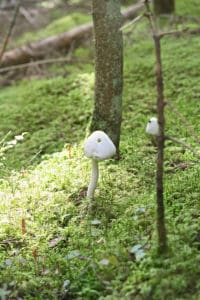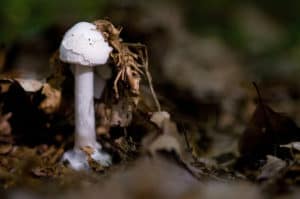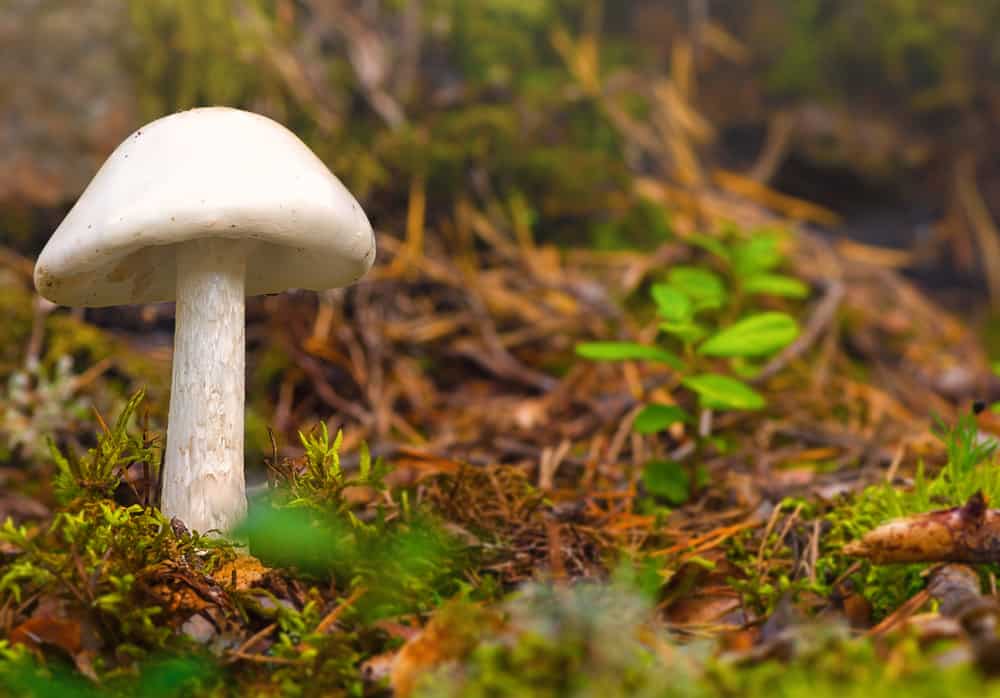The Destroying Angel: A Mushroom With Deadly Intentions
No matter which destroying angel is local to where you are, all of them are deadly poisonous. In the eastern United States, the destroying angel is Amanita bisporigera.
In the western states, it is Amanita ocreata. And, in Europe, both Amanita virosa and Amanita verna are labeled destroying angels.
The destroying angel is one of the most deadly mushrooms in the world. It is commonly found across North America and Europe.

Where is destroying angel found?
The eastern destroying angel (A.bisporigera) fruits in summer and fall among mixed coniferous and deciduous forests. Usually found singly, they also grow in scattered or close groups.
These mushrooms are thought to have symbiotic relationships with trees, specifically oak, but they are found near all types.
The west coast destroying angel (A.ocreata) fruits in mixed woodlands from January through April. It most commonly grows in association with coastal live oak.
How does destroying angel kill?
The toxin in destroying angel is a-amatin, the same found in the death cap, another Amanita species. It poisons the body by destroying liver and kidney function.
The symptoms of poison are minor, to start. They occur 6-12 hours after ingestion and include diarrhea, vomiting, gastrointestinal issues.
These symptoms pass after a while, then new symptoms start. Jaundice, hemorrhaging, delirium, seizures, and coma are just the beginning. Eventually, the kidney and liver failure, and death ensues.
How fast can a destroying angel kill?
Death is not immediate. There is almost always an “incubation period” of 6-12 hours before any symptoms occur at all.
If medical help is not received or is not effective, death will occur in 6-14 days. Survival rates significantly increase if medical treatment is received within 36 hours.
Is there a treatment for poisoning by death cap mushroom?
Yes. Medical professionals treat poison victims with dialysis and penicillin, among other things. Many cases require liver or kidney transplants.
The key to survival is seeking medical help immediately. The longer a person waits, the harsher the damage to the liver and kidneys.
Scientists are looking into an injection of silibinin, a derivative of milk thistle, as a promising treatment. Silibinin stops the liver from taking in the poison. In Europe, it is an approved treatment, but not in the United States.
What does the destroying angel look like?

A tall, white statuesque mushroom, the destroying angel earns its celestial name. The cap is smooth and white, averaging 1-4 inches in diameter.
The cap flesh is thin, white, and will not change color when bruised. When the destroying angel is young, it is egg-shaped, sitting atop the ground. As it matures, the stem extends, and the cap flattens out.
Gills are white, detached, and crowded. The stem is thick (not hollow) and long, ranging from 2.5-5.5 inches.
Around the stem, near the cap, a white membranous skirt sits like a ring, a remnant of a partial veil. The bottom of the stem is cup-shaped, like half an egg.
The cup, or volva, is often buried in the ground and difficult to see. For a definite identification, you may need to brush the leaf litter away or dig into the soil a little ways.
Can you touch a destroying angel?
Yes. It is the ingestion of the mushroom that is dangerous. However, that being said, it is highly recommended to wear gloves or wash hands immediately after handling a destroying angel.
It is common to touch the face or mouth inadvertently, which may transfer some of the poison, although this hasn’t been proven to happen. With this specimen, though, it is best to be cautious.
How much destroying angel will kill a person?
Half a cap, or a 1 oz piece, is enough to kill an adult human.
Is the destroying angel poisonous to dogs and cats?
Yes, to both dogs and cats. It acts the same way it does with humans, causing liver and kidney failure. Dogs may recover if treatment is started immediately.
Does the destroying angel have look-a-likes?
Yes, sort of. There are no edible mushrooms that look just like it, yet inexperienced folks may mistake the young egg-shaped version for a puffball or other edible mushroom. It is slightly similar to the popular horse mushroom, meadow mushroom, and common button mushroom.
Mostly, the similarity is in general shape and the white coloring. The stems, gills, partial veil, and volva are all distinctive identifying characteristics that set the destroying angel apart from others.
New foragers are cautioned not to collect any white mushroom species until all the types are learned, and identification is certain.
Accidental poisonings, based on misidentification, are the most common reason for poisonings. Children and pets may also ingest the mushroom by accident.




